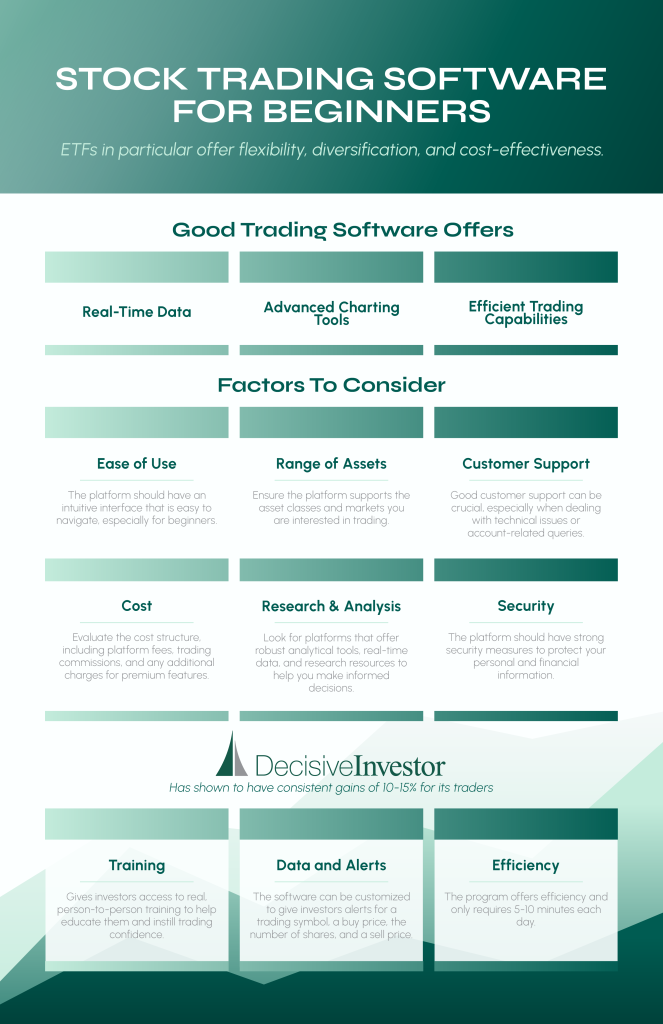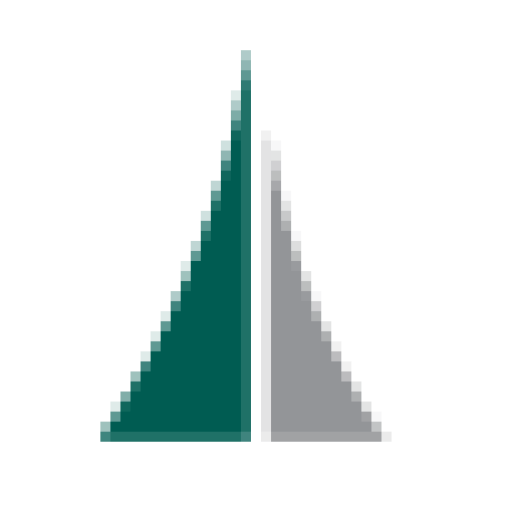
10 Best ETF Trading Software Programs for Investors
Investing in the stock market as well as investing in Exchange-Traded Funds (ETFs) has become increasingly popular. ETFs in particular offer flexibility, diversification, and cost-effectiveness. However, to maximize the potential of ETF trading, investors need robust software programs that offer powerful features such as real-time data, advanced charting tools, and efficient trading capabilities. Here, we will explore the 10 best trading software programs that can help investors enhance their trading strategies and achieve their financial goals.
1. Decisive Investor
Decisive Investor is one of the best software trading programs for beginners. It has been tested and has shown to have consistent gains of 10-15% for its traders. It helps take the guesswork out of investing.
- Training: Using Decisive Investor gives investors access to real, person-to-person training to help educate them and instill trading confidence.
- Data and Alerts: the software can be customized to give investors alerts for a trading symbol, a buy price, the number of shares, and a sell price.
- Efficiency: the program offers efficiency and only requires 5-10 minutes each day.
2. MetaTrader 5 (MT5)
MetaTrader 5 is an advanced trading platform that caters to a wide range of asset classes, including ETFs. It offers sophisticated tools for both novice and experienced traders:
- Advanced Order Management: Includes various order types for trading flexibility.
- Economic Calendar: Integrated economic news and events to inform trading decisions.
- Improved Charting and Analytical Tools: 21 timeframes and over 80 technical indicators, useful for tracking ETF performance.
3. Thinkorswim by TD Ameritrade
Thinkorswim is a comprehensive trading platform known for its powerful analytical tools and user-friendly interface. It caters to both novice and experienced traders with features such as:
- Real-Time Data and Alerts: Access to real-time market data and customizable alerts specific to ETF movements.
- Advanced Charting: Technical studies, drawing tools, and multiple chart types for analyzing ETF trends.
- Paper Trading: Simulated trading environment to practice ETF strategies without risk.
4. TradeStation
TradeStation is highly regarded for its robust trading tools and research capabilities, making it suitable for active traders. Key features include:
- Customizable Trading Strategies: EasyLanguage scripting language for creating custom indicators and strategies tailored to ETFs.
- Advanced Charting: Multiple chart styles, extensive drawing tools, and technical indicators.
- Backtesting: Historical data for testing trading strategies, including ETFs, before deploying them live.
5. Interactive Brokers’ Trader Workstation (TWS)
Trader Workstation by Interactive Brokers is a professional-grade trading platform that provides access to a wide range of markets and instruments, including ETFs:
- Advanced Trading Tools: Options analytics, risk management tools, and algo trading specifically for ETFs.
- Global Market Access: Trade ETFs from various international markets.
- Real-Time Monitoring: Comprehensive market data and portfolio management tools.
6. TradingView
TradingView is a web-based platform known for its powerful charting tools and social trading features, making it a favorite among ETF traders:
- Advanced Charting: Interactive charts with over 100 indicators and drawing tools to analyze ETF performance.
- Social Trading: Follow and share ideas with other ETF traders in the community.
- Custom Scripts: Pine Script for creating custom indicators and strategies focused on ETFs.
7. NinjaTrader
NinjaTrader is a popular platform for futures, forex, and stock trading, known for its advanced charting and automated trading capabilities, which are also beneficial for ETF traders:
- Customizable Interface: Tailor the platform to fit individual ETF trading styles and preferences.
- Automated Trading: Develop and deploy automated ETF trading strategies using NinjaScript.
- Extensive Educational Resources: Webinars, tutorials, and community forums for continuous learning about ETFs.
8. eSignal
eSignal is a premium trading platform that offers advanced charting, trading, and market analysis tools. It is suitable for traders who need comprehensive market data and analytics. Features include:
- Real-Time Market Data: Access to global exchanges with high-quality data feeds.
- Advanced Charting and Analysis: Over 100 technical indicators and drawing tools.
- Backtesting and Strategy Development: Test and refine trading strategies using historical data.
9. Fidelity Active Trader Pro
Fidelity’s Active Trader Pro is designed for active traders and offers robust tools and research capabilities, making it suitable for ETF trading:
- Real-Time Data: Comprehensive real-time data and news feeds tailored for ETFs.
- Advanced Charting Tools: Customizable charts and indicators to analyze trading trends.
- Trade Automation: Set up automatic trading strategies for ETFs based on specific criteria.
10. Ally Invest
Ally Invest offers a solid trading platform with a range of tools suitable for both new and experienced investors. It integrates seamlessly with other Ally Bank services, providing a comprehensive financial solution. Key features include:
- User-Friendly Interface: Intuitive platform that’s easy to navigate for ETF trading.
- Research and Analysis Tools: Access to detailed market analysis, news, and insights.
- Automated Portfolio Management: Robo-advisory services for hands-off investing.
Choosing the Right Trading Program
When selecting a stock trading platform, consider the following factors to ensure it meets your trading needs:
1. Ease of Use: The platform should have an intuitive interface that is easy to navigate, especially for beginners.
2. Cost: Evaluate the cost structure, including platform fees, trading commissions, and any additional charges for premium features.
3. Range of Assets: Ensure the platform supports the asset classes and markets you are interested in trading.
4. Research and Analysis Tools: Look for platforms that offer robust analytical tools, real-time data, and research resources to help you make informed decisions.
5. Customer Support: Good customer support can be crucial, especially when dealing with technical issues or account-related queries.
6. Security: The platform should have strong security measures to protect your personal and financial information.
Investing in the right software trading program can significantly enhance your trading experience and improve your chances of success in the financial markets. Each of the platforms mentioned above offers unique features and tools tailored to different trading styles and preferences. Whether you are a novice investor looking to learn the ropes or an experienced trader seeking advanced tools and analytics, there is a trading program out there to meet your needs.
Take the time to research and test different platforms, utilizing demo accounts where available, to find the one that best aligns with your trading goals and strategy. By leveraging the capabilities of these top trading programs, you can make more informed decisions, manage your investments more effectively, and ultimately, achieve your financial objectives.


